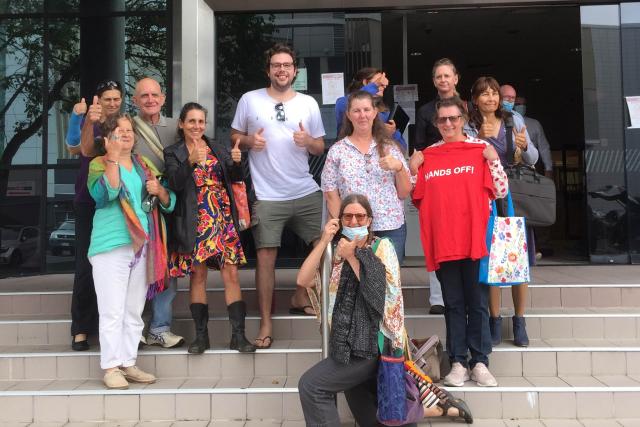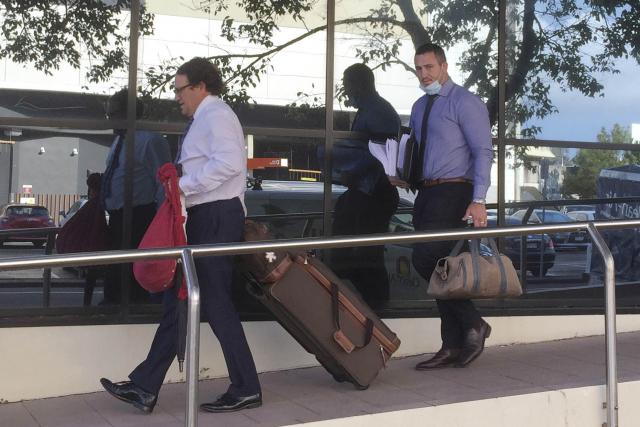In his opening address in the long-awaited case of Noosa Council v Kin Kin Quarry, council’s barrister Mitchell Baty told the Maroochydore Planning and Environment Court on Wednesday 2 March the application filed by council was for relief for the community from haulage trucks in five areas.
In front of presiding Judge Gary Long and with a public gallery filled with hinterland residents Mr Baty outlined Council’s case that centred on the quarry’s non-compliance of its Quarry Management Plan and that the impact of the quarry’s intensification of work constitutes a material change of use.
There has been a failure to avoid convoying of trucks, Mr Baty said.
Trucks have failed to cover loads, which is required in the QMP, apart from haulage of large boulders the quarry has not operated between the QMP-approved operating hours from 6am to 6pm Monday to Friday and 7am to 5pm Saturday, the request to reduce quarry trucks on the roads during school bus hours has not occurred, he said.
“All these matter go to the requirements of an approval in 2016 granted by this court to operate in accordance with the QMP.“
The fifth issue relates to whether there has been a material change of use (MCU) on the land.
“The respondents suggest the MCU is determined by two things – the rate of extraction of material from the ground each year and the proper development approval. They say they have an ERA (extraction rate activity) of one million tonnes per year,“ he said.
“We say this has little relevance without the proper development approval.“
Mr Baty said Council’s MCU was not just resolved by the extraction rate but had quantitative and qualitative considerations.
Noosa Council’s current planning scheme, the number of truck movements on the road, the time of day of operations, resident complaints, impacts on in a rural environment and traffic safety are all considerations, he said.
“It’s inappropriate for tonnage extracted to be the determinant of this issue.“
To support the case Mr Baty and his associate Susan Hedge submitted numerous affidavits from experts including a town planner and traffic engineer, council officers, school bus driver and residents. Included in submissions were measurements of quarry truck movements, photographic evidence and resident impact statements.
The reserves of the quarry are estimated at 24 million tonnes and the quarry life at about 30 years. The QMP that was established for former operator Nielson and not updated since it was taken over by Cordwell Resources about two years ago, outlines activities of the quarry such as safety, ensuring the amenity of the site and environment and fostering good relationships with the local community, Mr Baty said.
A traffic management plan sets out objectives that include managing haulage on the roads that make community safety a priority, that minimise community traffic complaints and ensures no incidents or accidents.
“Complaints are evidence of a very concerned community,“ he said.
Representing quarry operator Cordwell Resources and owners of the land, who did not want to be involved, barrister Errol Morzone, QC, told the court that, in short, the quarry had a development permit to operate as an extractive industry with an extraction limit under a QMP of 1million tonnes per annum.
He said the quarry had a long history of operating approval. It was recognised as a key resource area in the State planning policy, identified as the largest rock resource in the shire and was operated by council from 1995 to 2008, and prior to the QMP of 2016 had no limits on extraction amount or haulage traffic, he said.
Mr Morzone said in 2010 the Kin Kin Community Group challenged the quarry operators, with the court finding the quarry was not limited on amount or size. In 2016 a QMP was set out by council.
Only the provisions of the development approval requires the quarry to be operated under the provisions of the QMP. The QMP is not an approval, it is a management document for the purposes of management, he said.
These allegations deal with breaches of the management plan. What’s been alleged is that breach of the QMP constitutes an offence.
“In this case the council is trying to construe a management document for purposes of committing an offence,“ he said.
Mr Morzone said his client strongly objected to the allegations.
There are only four allegations – travelling during school bus times, operating outside hours, travelling in convoy and with uncovered loads. These are the allegations, not other alleged allegations by material intensification in use. “If there has been intensification of use it has been without authority required,“ he said.
“What is sought is a consideration the development approval has been contravened.“
To support his case Mr Morzone and associate David Purcell planned to call experts including a town planner and traffic engineer as well as quarry operator Martin Cordwell, contractors and employees and submitted a number of affidavits.
With the detail so important to the case the barristers spent hours on Wednesday afternoon and Thursday morning raising objections to affidavits received, with paragraphs and in some instances sentences ruled inadmissible in the case, before witnesses were called.
Noosa Council officer Gary Dalton was the first witness called by Noosa Council’s barrister Mr Baty and cross examined by Mr Morzone, whose interest was in the location of cameras installed by Mr Dalton to collect information on quarry truck movements.
He was followed in the witness box by Martin Williams, principal of Austraffic, a traffic engineering and information technology business, who Mr Morzone questioned on his methods of obtaining information on truck movements and processes of traffic recording and analysis. He was followed by Council’s development engineer Diogo Carrico, who told the court how he recorded breaches by viewing photos from cameras installed by Mr Dalton.
Mr Baty called expert witness, town planner Terence Buckley, who was questioned by Mr Morzone for several hours about the significance of the quarry as a resource, the role of the QMP and the extraction rate of the quarry.
Mr Buckley described the QMP as an inherent link in a planning sense in the approval and conditions and through the management plan limitations are placed on the site and external to the site.
He said the state planning policy goes so far to say the resource was important to the region, not what happens next. The council has to protect the resource but the development approval is subject to normal checks and balances, he said.
“One of the conditions inherent in the rate of extraction is how it is to be carted through a sensitive area. The environment has a particular amenity, a particular value already recognised. The management plan talks about the rural environment. It deals with these things. There’s evidence there’s been a material change and that’s through the impacts,“ he said.
“There’s a limit to the rate extraction can occur. It’s rural, there are people living there, children going to school there, winding roads. The people who wrote the plans say we will minimise impact. It’s difficult to see that occurring. There are expectations these residents in the area must recognise the existence of the quarry but the reasons shouldn’t be put to the scale this has occurred that requires our attention today.“
Mr Morzone called on his expert witness, town planner Steven Reynolds, who told Mr Baty that he didn’t have cause to read the affidavits of local residents or the traffic report from Austraffic.
“I’m aware conditions have been breached in regard to uncovered loads and truck movements,“ he said.
“The approval will authorise the current use or form the basis of the approved development plan.“
The development plan doesn’t place limits on traffic movements, convoying, covering loads. The QMP does deal with these matters. If these have been breached it’s an enforcement question. It’s not a material change of use. It’s a management issue, he said. “In this case the non-compliance is irrelevant in the allegations put in the original application. The impacts are the kind of impacts that are contemplated in the QMP. Every point raised is contained in the QMP for which there are conditions that apply through the QMP. The QMP includes requirements on how quarry trucks are to operate. It’s in a traffic management plan. The community should take into account the relevant approval has been in place for 30 years,“ he said.
Traffic engineers Stuart Holland (for Noosa Council) and Bryce Trevilyan (for Cordwell’s Resources) followed each other to give evidence.
Mr Holland told the court his analysis of traffic conditions including the pavement width on Pomona-Kin Kin Road of 6-6.5m, (bearing in mind the standard is 7m), road markers close to the pavement and trucks having to move off the pavement to pass made it clear to him how inappropriate the road was for the volume of trucks.
Mr Morzone said crash data since 2010 showed zero accidents.
“If the quarry proposes to send 75 trucks a day improvements need to be make to be safe,“ Mr Holland said. He said his analysis of truck movements through the morning, excluding the first 15 minutes during which there was a rush of trucks heading to the quarry, showed 32 per cent travelled during school bus hours.
With 25 years in the industry and having worked on 80 quarry projects Mr Trevilyan said in his experience quarries initially extracted material at a lower rate before a “ramp up“ period. He acknowledged there were three categories of extraction approvals – 1-100,000 tonnnes/annum, 100,000-1million tonnes/annum and 1m plus with Cordwell’s ERA contained in the 100,000-1m tonnnes/annum category.
Mr Trevilyan agreed the width constraints on Pomona-Kin Kin Road made it a challenging experience and accepted it was more challenging with more larger vehicles.
He said Cordwell’s had installed a exit boom gate timed at five minute 15 second intervals to reduce convoying of haulage trucks.
Outside the court Kin Kin residents said the case had been a long time coming and it was good to hear experts telling the court what they had been saying for 18 months.
The roads are unsafe, they said.
“We know people in Kin Kin who don’t go out anymore. They’re too scared to go out.“
The residents said they drive at 40km/hr at heightened awareness which they attribute to being no serious accidents but several had been run off the road.
The case has been rescheduled to resume on Monday 28 March.








